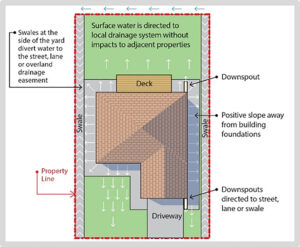
Rainy Season is Coming
Lot drainage is essential for any building project. Proper drainage ensures that water is effectively directed away from the building’s foundation, preventing water damage and potential foundation problems. In this blog, I’ll discuss the importance of lot drainage, the different types of lot drainage systems, and some tips on how to maintain them.
Importance of Lot Drainage
Lot drainage is crucial for maintaining the structural integrity of a building. Poor drainage can cause water to collect around the foundation, leading to problems like cracks, settling, and erosion. This, in turn, can lead to moisture in the basement, compromise the building’s stability and at the greatest extreme cause it to collapse.
Proper lot drainage also protects the landscaping around the building. Excess water can drown plants, cause soil erosion, and create muddy and unsightly areas on the property. Good lot drainage ensures that water is directed away from the property, allowing for healthy plant growth and a visually appealing landscape.
Types of Lot Drainage Systems
There are several types of lot drainage systems available. The most common are:
1. Surface Drainage – This is a system that directs water away from the property’s surface. It includes gutters, downspouts, and grading to ensure water flows away from the building.
2. French Drain – This system consists of a trench filled with gravel or rock and a perforated pipe. The pipe collects water and directs it away from the foundation.
3. Channel Drain – This system is typically installed along a driveway or other large, paved surfaces. It includes a trench filled with gravel or rock and a drain cover that collects and directs water away from the surface.
4. Sump Pump – This system is designed to direct water from around the base of the foundation into a pit and then pumps water out and away from the property before it can seep into the basement.
Maintaining Lot Drainage Systems
Maintaining lot drainage systems is crucial for ensuring their effectiveness. Here are some tips to keep in mind:
1. Regularly clean gutters and downspouts to prevent clogs that can cause water to overflow and damage the building’s foundation.
2. Ensure that the grading around the property is sloped away from the building. This helps to direct water away from the foundation.
3. Inspect and clean French drains, channel drains, and sump pumps regularly to ensure that they’re functioning correctly.
4. Keep an eye out for signs of water damage, such as cracks in the foundation, water stains on walls, or a damp or musty smell in the basement. Addressing these issues early can prevent more extensive and costly repairs down the line.
Lot drainage is a critical aspect of any building project. Proper drainage ensures that water is directed away from the foundation, protecting the building’s structural integrity, and preventing water damage. Several types of lot drainage systems are available and maintaining them is essential for their effectiveness. By following the tips outlined, you can ensure that your lot drainage system is functioning correctly, protecting your property and landscaping for years to come.
Kyle

